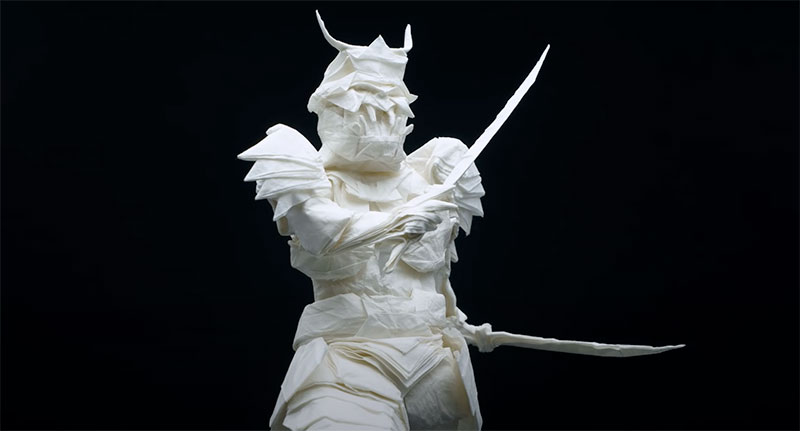Origami artist Juho Könkkölä spent 50 hours folding an origami samurai from a single square sheet of paper, with no cutting or ripping used in the process. He describes his process on Reddit:
Folded from a single square sheet of 95cm x 95cm Wenzhou rice paper without any cutting. The finished size of the work is 28cm x 16cm x 19cm. Only dry and wet folding techniques were used to fold the model. It took 2 months to design and 1 month to fold, although I was working on few other projects during that time too.
It took some effort and experimentation to fold the texture for the armor, while trying to simplify it to be somewhat manageable to fold. I folded 4 rough test attempts in total, and all of them took 3 days to fold each. There are several hundreds of steps to fold it from the square and there are probably thousands of individual folds. The asymmetry in the design allowed me to include sword on only one arm, while being able to make the character look symmetric.
Find the finished product below. Watch the creative process, from start to finish, above.

Would you like to support the mission of Open Culture? Please consider making a donation to our site. It’s hard to rely 100% on ads, and your contributions will help us continue providing the best free cultural and educational materials to learners everywhere.
Also consider following Open Culture on Facebook and Twitter and sharing intelligent media with your friends. Or sign up for our daily email and get a daily dose of Open Culture in your inbox.
Related Content:
MIT Creates Amazing Self-Folding Origami Robots & Leaping Cheetah Robots
Designer Creates Origami Cardboard Tents to Shelter the Homeless from the Winter Cold
Download Classic Japanese Wave and Ripple Designs: A Go-to Guide for Japanese Artists from 1903
Hundreds of Wonderful Japanese Firework Designs from the Early-1900s: Digitized and Free to Download
An Origami Samurai Made from a Single Sheet of Rice Paper, Without Any Cutting is a post from: Open Culture. Follow us on Facebook, Twitter, and Google Plus, or get our Daily Email. And don't miss our big collections of Free Online Courses, Free Online Movies, Free eBooks, Free Audio Books, Free Foreign Language Lessons, and MOOCs.
from Open Culture https://ift.tt/2KnZ9ub
via Ilumina

Comments
Post a Comment